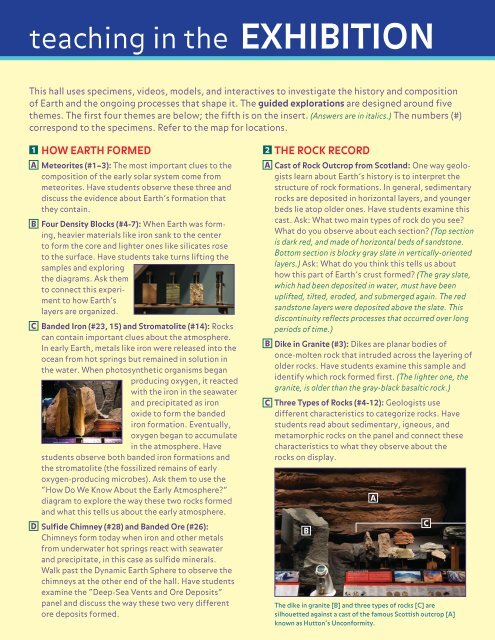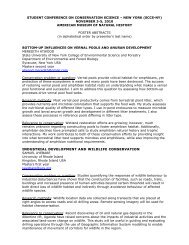PLANET EARTH - American Museum of Natural History
PLANET EARTH - American Museum of Natural History
PLANET EARTH - American Museum of Natural History
- No tags were found...
Create successful ePaper yourself
Turn your PDF publications into a flip-book with our unique Google optimized e-Paper software.
teaching in the EXHIBITIONThis hall uses specimens, videos, models, and interactives to investigate the history and composition<strong>of</strong> Earth and the ongoing processes that shape it. The guided explorations are designed around fivethemes. The first four themes are below; the fifth is on the insert. (Answers are in italics.) The numbers (#)correspond to the specimens. Refer to the map for locations.HOW <strong>EARTH</strong> FORMED1 2ABCMeteorites (#1–3): The most important clues to thecomposition <strong>of</strong> the early solar system come frommeteorites. Have students observe these three anddiscuss the evidence about Earth’s formation thatthey contain.Four Density Blocks (#4-7): When Earth was forming,heavier materials like iron sank to the centerto form the core and lighter ones like silicates roseto the surface. Have students take turns lifting thesamples and exploringthe diagrams. Ask themto connect this experimentto how Earth’slayers are organized.Banded Iron (#23, 15) and Stromatolite (#14): Rockscan contain important clues about the atmosphere.In early Earth, metals like iron were released into theocean from hot springs but remained in solution inthe water. When photosynthetic organisms beganproducing oxygen, it reactedwith the iron in the seawaterand precipitated as ironoxide to form the bandediron formation. Eventually,oxygen began to accumulatein the atmosphere. Havestudents observe both banded iron formations andthe stromatolite (the fossilized remains <strong>of</strong> earlyoxygen-producing microbes). Ask them to use the“How Do We Know About the Early Atmosphere?”diagram to explore the way these two rocks formedand what this tells us about the early atmosphere. D Sulfide Chimney (#28) and Banded Ore (#26):Chimneys form today when iron and other metalsfrom underwater hot springs react with seawaterand precipitate, in this case as sulfide minerals.Walk past the Dynamic Earth Sphere to observe thechimneys at the other end <strong>of</strong> the hall. Have studentsexamine the “Deep-Sea Vents and Ore Deposits”panel and discuss the way these two very differentore deposits formed.A B CTHE ROCK RECORDCast <strong>of</strong> Rock Outcrop from Scotland: One way geologistslearn about Earth’s history is to interpret thestructure <strong>of</strong> rock formations. In general, sedimentaryrocks are deposited in horizontal layers, and youngerbeds lie atop older ones. Have students examine thiscast. Ask: What two main types <strong>of</strong> rock do you see?What do you observe about each section? (Top sectionis dark red, and made <strong>of</strong> horizontal beds <strong>of</strong> sandstone.Bottom section is blocky gray slate in vertically-orientedlayers.) Ask: What do you think this tells us abouthow this part <strong>of</strong> Earth’s crust formed? (The gray slate,which had been deposited in water, must have beenuplifted, tilted, eroded, and submerged again. The redsandstone layers were deposited above the slate. Thisdiscontinuity reflects processes that occurred over longperiods <strong>of</strong> time.)Dike in Granite (#3): Dikes are planar bodies <strong>of</strong>once-molten rock that intruded across the layering <strong>of</strong>older rocks. Have students examine this sample andidentify which rock formed first. (The lighter one, thegranite, is older than the gray-black basaltic rock.)Three Types <strong>of</strong> Rocks (#4-12): Geologists usedifferent characteristics to categorize rocks. Havestudents read about sedimentary, igneous, andmetamorphic rocks on the panel and connect thesecharacteristics to what they observe about therocks on display.BThe dike in granite [B] and three types <strong>of</strong> rocks [C] aresilhouetted against a cast <strong>of</strong> the famous Scottish outcrop [A]known as Hutton’s Unconformity.AC
















